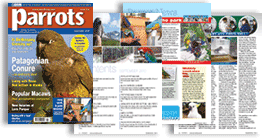
Buy your copy now!
Save money if you subscribe - 12 issues for the price of 11
In this issue...
- Is Birdkeeping Growing Up? - read more
- New Aviaries for Lories - read more
- Using Words to Guide Your Parrots Behavior - read more
- Popular Pet Macaws - read more
- The Patagonian Conure - read more
- Living with Rosie Red Bottom - read more
- News, Bird Alert, Readers Story and FREE classified advertising
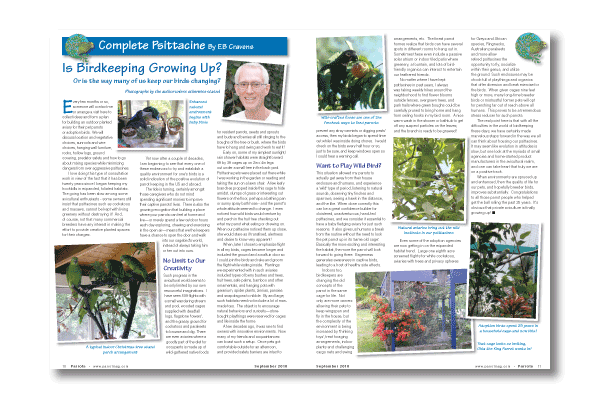
Is Birdkeeping Growing Up? Or is the way many of us keep our birds changing? By EB Cravens
Every few months or so, someone will contact me or arrange a visit here to collect ideas and form a plan for building an outdoor planted aviary for their pet parrots or adoption birds. We will discuss location and vegetative choices, sunroofs and wire choices, hanging wall furniture, rocks, hollow logs, ground covering, predator safety and how to go about mixing species while minimizing dangers from over aggressive psittacines.
I love doing this type of consultation work in view of the fact that it has been twenty years since I began keeping my hookbills in expanded, foliated habitats. The going has been slow among some avicultural enthusiasts - some owners still insist that psittacines such as cockatoos and macaws, cannot be kept with living greenery without destroying it! And, of course, not that many commercial breeders have any interest in making the effort to provide creative planted spaces for their charges.
Yet now after a couple of decades, I am beginning to see that every one of these endeavors to try and establish a quality environment for one’s birds is a solid indication of the positive evolution of parrot keeping in the US and abroad.
Read more in the magazine…
Buy a copy now!
BACK
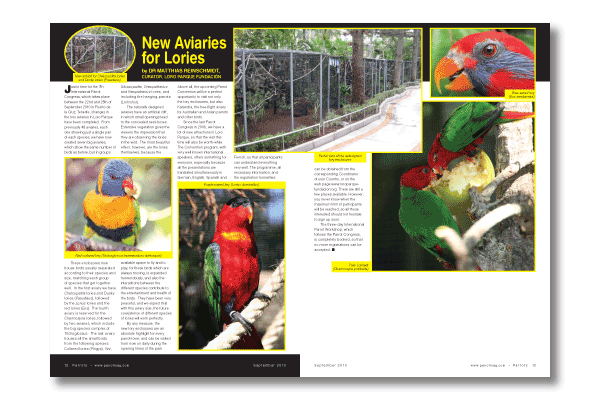
By Dr Matthias Reinschmidt, Curator, Loro Parque Fundación
Just in time for the 7th International Parrot Congress, which takes place between the 22nd and 25th of September 2010 in Puerto de la Cruz, Tenerife, changes in the lory aviaries in Loro Parque have been completed. From previously 48 aviaries, each one showing just a single pair of each species, we have now created seven big aviaries, which show the same number of birds as before, but in groups.Read more in the magazine…
Buy a copy now!
BACK
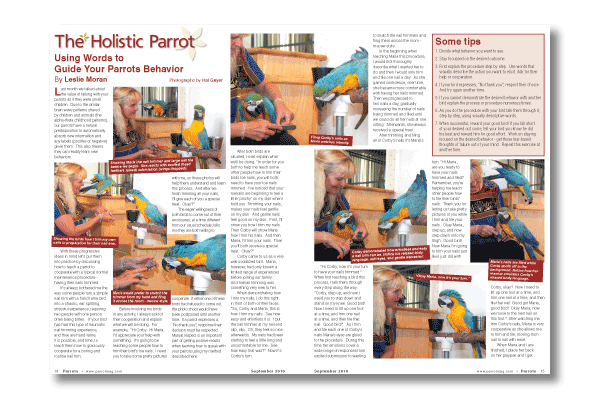
By Leslie Moran
Last month we talked about the value of talking with your parrots as if they were small children. Due to the similar brain wave patterns shared by children and animals (the alpha-theta childhood patterns), our parrots have a natural predisposition to automatically absorb new information and any labels (positive or negative) given them. This also means they can readily learn new behaviors.
With these progressive ideas in mind let’s put them into practice by discussing how to teach a parrot to cooperate with a typical normal maintenance procedure - having their nails trimmed.
It’s always bothered me the way some people turn a simple nail trim with a hand tame bird into a chaotic, ear splitting, stressful experience, requiring two people with one person often being bitten. If your bird has had this type of traumatic nail trimming experience, and they are hand-tame, it is possible, and time, to teach them how to graciously cooperate for a boring and routine nail trim.
Read more in the magazine…
Buy a copy now!
BACK
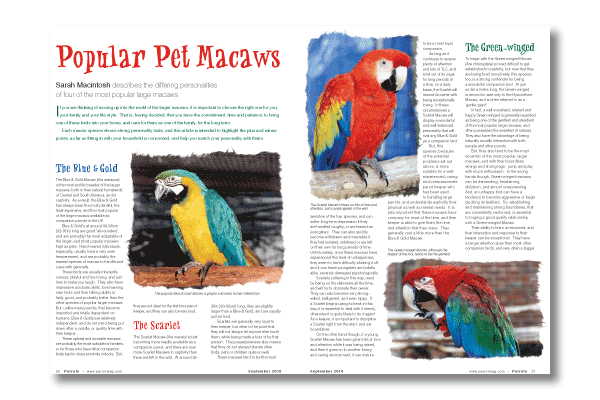
Sarah Macintosh describes the differing personalities of four of the most popular large macaws
If you are thinking of moving up into the world of the larger macaws, it is important to choose the right one for you, your family and your life-style. That is, having decided, that you have the commitment, time and patience, to bring one of these birds into your home, and care for them as one of the family, for the long-term.
Each macaw species shows strong personality traits, and this article is intended to highlight the plus and minus-points, as far as fitting in with your household is concerned, and help you match your personality with theirs.
Read more in the magazine…
Buy a copy now!
BACK

By Pauline James
The captive population of the Patagonian Conure (Cyanoliseus patagonus) in the UK has soared since the 1990s, as its merits as an aviary subject have come to the fore, and its virtues as a hand-tame companion parrot have been experienced and become more widely embraced. But, as anyone who already keeps this species will tell you, the Patagonian is no ordinary bird.
The head of this large and rather unusually-coloured conure, in its tones of predominantly light olive-green and greenish-gold, is totally brought to life by its stunning pale creamy-yellow eyes set in over-sized bright-white tapered eye-rings, and is actually quite beautiful when you step back and give it another glance. But, the colour of a Patagonian’s plumage isn’t the only difference that sets it apart from the other conure species.
In the wild, Patagonian conures do not nest in trees, like other conure species, but breed communally in the sheer face of a sandstone or limestone cliff, that typically borders a river or the sea. Each pair tunnel their way, through the soft substrata using their strong beaks and their unusually large flesh-coloured feet. This burrowing habit is probably also the reason why Patagonians are the only conure species to have their nostrils completely covered by feathers.
Read more in the magazine…
Buy a copy now!
BACK






